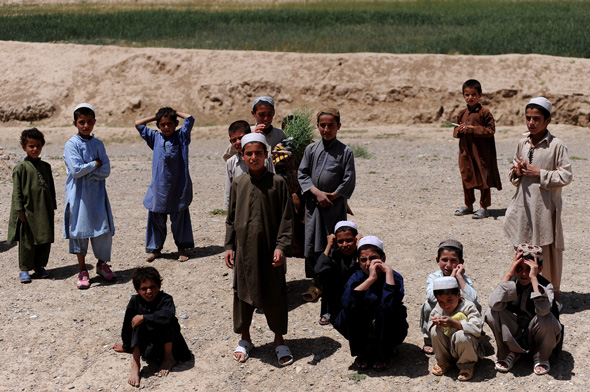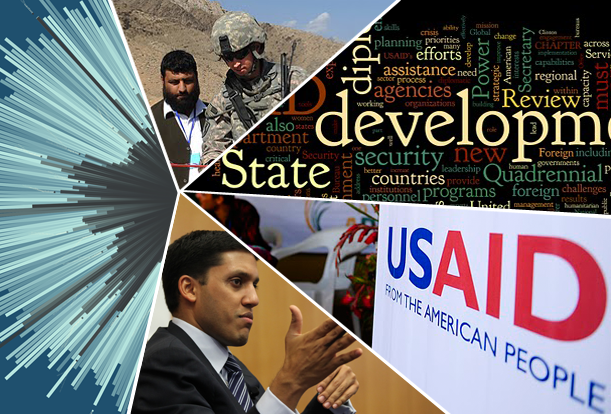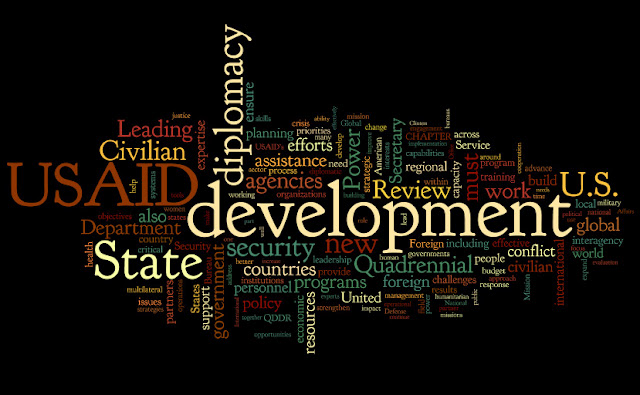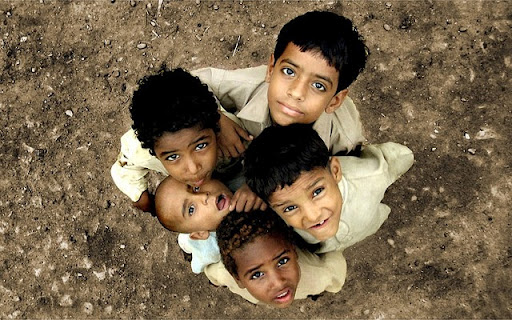-
Dot-Mom // From the Wilson Center
Delivering Solutions: Advancing Dialogue to Improve Maternal Health
“Throughout the 2009-2011 Advancing Dialogue on Maternal Health lecture series, we always heard the same good news: we know how to save the lives of women and girls. But more political will is needed,” said Calyn Ostrowksi, program associate for the Wilson Center’s Global Health Initiative on December 15 for the launch of the series’ culminating report, Delivering Solutions: Advancing Dialogue To Improve Maternal Health.MORE
Joining Ostrowski were co-author Margaret Greene, director of GreeneWorks; Luc de Bernis, senior advisor on maternal health at the UN Population Fund; Tim Thomas, interim director for the Maternal Health Task Force; and Chaacha Mwita, director of communications at the African Population and Health Research Center.
One of the few forums dedicated to maternal health, the series brought together senior-level policymakers, academic researchers, members of the media, and NGO workers from the United States and abroad. The series consisted of 21 separate events, with hundreds of experts sharing their experiences and thousands of participants and stakeholders providing their expertise. The final report captures, analyzes, and synthesizes the strategies and recommendations that emerged from the series.
Promoting Social Change
Unlike other health issues, said Green during her presentation on the findings of Delivering Solutions, the field of maternal health requires a holistic and multi-faceted approach; that is, an approach that looks not only at health systems, but also at underlying social factors. The report divides maternal health into three broad categories: social, economic, and cultural factors; health systems factors; and research/data demands.
Looking first at the social, cultural, and economic issues, Greene highlighted the need to improve nutrition and educational opportunities for young women in developing countries. Policymakers must be convinced that investing in women is not just good for women but good for families and children, she said. The participation of male partners and other male family members is also needed to increase access to maternal health services, such as family planning, and promote gender equality. The report pointed to a number of recommendations to promote male engagement:- Target interventions that educate men about danger signs and pregnancy complications.
- Address pressures that many young married men feel to prove their fertility.
- Inform men about sexual rights and how they relate to the health and wellbeing of their partners.
Health systems and medical resources play an equally pivotal role in reducing maternal mortality as social factors. The report highlights several key areas for strengthening the health system including the expansion of healthcare workers, health finance schemes, technology, and commodity distribution.
One key recommendation is to integrate reproductive health and maternal health supply chains. Four key medicines, oxytocin misoprostol, magnesium sulfate, and manual vacuum aspirators, target the three leading causes of maternal mortality (post-partum hemorrhage, obstructed labor, and unsafe abortion). Efforts to improve the distribution of these commodities should be more widely dispersed in developing countries and supported by community-based interventions. Women in urban slums, for example, face unique challenges that are not being adequately addressed.
Additionally, new technologies should be more creatively and effectively used, in particular the use of mobile phones in rural communities.
Many of the policy recommendations offered by the report, as Greene pointed out, are low-cost and highly effective. Yet three significant challenges remain for the field in general:- Six countries – Afghanistan, Democratic Republic of Congo, Ethiopia, India, Nigeria, and Pakistan – account for over half of the maternal deaths worldwide. The unique problems of each of these countries must be addressed and solved.
- Integration of maternal health with existing health services along with an over-reliance on community health workers can overburden weak infrastructure.
- Unnecessary cesarean births are on the rise as more women deliver in private sector facilities. These births cost 2 to 18 times as much as vaginal births and create unnecessary risks for mothers.
Chaacha Mwita of the African Population and Health Research Center (APHRC), located in Nairobi has seen firsthand the result of an overburdened and inadequate maternal health system in both his personal and professional life. Mwita endorsed the findings of the series report, emphasizing in particular the focus on transportation systems, male involvement, stakeholder dialogue, and education.
Mwita said that collaboration at all levels is the key to improving maternal health. Policymakers must communicate with researchers, who, in turn, must communicate with doctors, nurses, and hospital administrators in the field. The collaborative in-country dialogue series between the Wilson Center and APHRC, he believes, was a highly useful and easily replicable way of encouraging dialogue among relevant stakeholders in the field.
The Big Picture
”Our hope is that we’ve been able to seed discussions,” said Tim Thomas of the Maternal Health Task Force, one of the co-sponsors of the maternal health series. “We hope those seeds will take root and flourish.” Luc de Bernis, senior maternal health advisor of UNFPA, echoed Thomas’ sentiments, emphasizing the need for continued dialogue.
While maternal health has drawn increased international attention, creating political agreement among policymakers is a complex and often difficult process. There has been marked, though uneven, progress in improving maternal health across the globe, but more must be done. The Delivering Solutions report provides a state of the field assessment as well recommendations for existing, easy-to-implement solutions.
Event Resources:Topics: Africa, Dot-Mom, From the Wilson Center, funding, gender, global health, Kenya, maternal health, video -
Family Planning Can Help in Afghanistan
September 6, 2011 // By Wilson Center StaffMOREThe original version of this op-ed, by Jennifer Dabbs Sciubba, appeared in The Philadelphia Inquirer.
Most experts agree that the mark of long-term success in Afghanistan will be stable governance that allows the economy, democracy, and the people to flourish. Many factors will determine that, but a major one that seems to be left out of most high-level conversations is population.
Afghanistan is a country of 31 million people, but that number will double by 2035, according to the most recent UN projections, and could reach 126 million by midcentury. That’s 95 million more Afghans to govern, clothe, feed, and employ.
Without attention to population, countries like Afghanistan and Pakistan stand a good chance of staying mired in poverty, conflict, and corrupt, repressive government. That is why sustained investment in family planning by the United States and other countries would do more to stabilize the political climate there than any other foreign policy initiative. Though efforts by the Afghan government to provide contraceptives have met some resistance by conservative Muslim groups, the success of family planning in other Muslim states demonstrates that it can be effective.
Continue reading on The Philadelphia Inquirer.
Sources: UN Population Division.
Photo Credit: “100430-F-2616H-050,” courtesy of flickr user Kenny Holston 21 (Kenny Holston). -
Watch: Richard Cincotta on Political Demography and Unrest in the Middle East
March 9, 2011 // By Schuyler Null“Countries that have a high proportion of young people are typically more prone to political violence,” said demographer-in-residence at the Stimson Center, Richard Cincotta, in this interview with ECSP. “That is, not necessarily international war [but] internal conflict, which may take different forms,” including civil and ethnic strife, domestic terrorism, and violent political demonstrations.MORE
The role of unemployed and angry youths in the recent unrest that has swept the Middle East has received a great deal of coverage, but though the region in general is very young, some countries are more so than others.
Tunisia (median age of 29) is actually well into its demographic transition, where fertility declines towards replacement level. “Fertility – the number of children women have in their lifetime – is now lower than it is in the United States,” said Cincotta. As a result, Tunisia’s prospects for achieving a stable, liberal democracy – based on the historical relationship between age structure and political freedoms (see Cincotta’s full post on Tunisia and the two follow-ups for a more complete treatment of that relationship) – are about even.
In contrast, Egypt’s age structure remains young (median age of 24) and Yemen’s (median age of 17) is extremely young. “Those difference are very stark,” said Cincotta, and they play out in the risk of political violence: Tunisia is less likely to experience continuing political violence; Egypt, more so; and Yemen, even more likely.
The relationships between age structure and political violence and the emergence of democratic institutions can be useful in other conflict-prone regions as well. “Afghanistan, Pakistan, Iraq, the Palestinian Authority, most of the central band of sub-Saharan Africa – from Nigeria to the Congo, to Kenya and Ethiopia – we know that these countries are volatile, we’re not always sure why,” said Cincotta. But “age structure gives you a clue, because it tells you something about a lot of barriers that are important to development.”
Sources: UN Population Division.Topics: Afghanistan, Africa, conflict, democracy and governance, demography, development, DRC, Egypt, Ethiopia, Iraq, Kenya, Middle East, Pakistan, Tunisia, video, youth -
QDDR Coverage Wrap-up: Institutional Shifts, Development-as-Security, Women’s Empowerment, and Complex New Threats
February 23, 2011 // By Schuyler NullMORESomewhat lost in the wake of turmoil in the Middle East and the budget battle in Congress has been the State Department’s most aggressive attempt yet to reshape itself for the dynamic foreign policy challenges of the 21st century.
Topics: Afghanistan, development, foreign policy, gender, global health, Iraq, Middle East, military, QDDR, Reading the QDDR, State, youth -
Women and Youth in 21st Century Statecraft
January 10, 2011 // By Richard CincottaMOREWhether one supports or finds fault with current (and envisioned) U.S. diplomacy and international development processes and practices, most foreign policy analysts and academics will recognize the first Quadrennial Diplomatic and Development Review (QDDR) as a landmark document. In my opinion, the QDDR – titled Leading Through Civilian Power – is essential reading for those who seek a career in government or who otherwise need to understand the nature and purpose of the work that foreign service officers and USAID missions perform overseas.
Topics: development, funding, gender, Middle East, QDDR, Reading the QDDR, security, South Asia, State, youth -
A Crucial Connection: India’s Natural Security
January 5, 2011 // By Michael KugelmanMOREExcerpted from the original op-ed, “A Crucial Connection,” by Michael Kugelman in The Times of India:
With India’s soaring growth and rising global clout hogging media headlines, it is easy to forget the nation is beset by security challenges. Naxalite insurgency rages across more than two-thirds of India’s states, while long-simmering tensions in Jammu and Kashmir exploded once again this summer. Meanwhile, two years post-Mumbai, Pakistan remains unwilling or unable to dismantle the anti-India militant groups on its soil. Finally, China’s military rise continues unabated. As Beijing increases its activities across the Himalayan and Indian Ocean regions, fears about Chinese encirclement are rife.
It is even easier to forget that these challenges are intertwined with natural resource issues. Policy makers in New Delhi often fail to make this connection, at their own peril. Twenty-five per cent of Indians lack access to clean drinking water; about 40 per cent have no electricity. These constraints intensify security problems.
India’s immense energy needs – household and commercial – have deepened its dependence on coal, its most heavily consumed energy source. But India’s main coal reserves are located in Naxalite bastions. With energy security at stake, New Delhi has a powerful incentive to flush out insurgents. It has done so with heavy-handed shows of force that often trigger civilian casualties. Additionally, intensive coal mining has displaced locals and created toxic living conditions for those who remain. All these outcomes boost support for the insurgency.
Meanwhile, the fruits of this heavy resource extraction elude local communities, fuelling grievances that Naxalites exploit. A similar dynamic plays out in Jammu and Kashmir, where electricity-deficient residents decry the paltry proportion of power they receive from central government-owned hydroelectric companies. In both cases, resource inequities are a spark for violent anti-government fervor.
Continue reading on The Times of India.
For more on India’s Naxalite rebellion and its natural resource drivers, see The New Security Beat’s “India’s Maoists: South Asia’s ‘Other’ Insurgency.”
Michael Kugelman is program associate with the Asia Program at the Woodrow Wilson International Center for Scholars.
Photo Credit: “Mysore Coal Man,” courtesy of flickr user AdamCohn.Topics: conflict, economics, energy, environmental security, India, livelihoods, minerals, natural resources, water -
Whither the Demographic Arc of Instability?
December 14, 2010 // By Richard CincottaMORE
After the Berlin Wall came down in 1989, the demand for geostrategic mapping went up. Pentagon geographers revised maps almost monthly in order to keep pace with the rapid sequence of events – the toppling of Eastern Europe’s communist regimes, the rise of pro-Western liberal democracies in their place, and the reunification of Germany. Then came more borders, and even more maps: the breakup of the Soviet Union and the withdrawal of forces from former Warsaw-Pact states, the splintering of Yugoslavia and Czechoslovakia, and requests for accession to NATO. When, in the late 1990s, it became apparent that the end of the Cold War would have little effect on the emergence of civil and ethnic conflicts in Africa, Asia, and Latin America, and that a network of militant Islamist organizations had coalesced across Muslim Asia and Africa, strategic mapmaking shifted focus to identifying conditions in the Global South.
Topics: Africa, conflict, demography, development, economics, livelihoods, Middle East, military, population, security, South Asia, Yemen, youth -
Guest Contributor
From Cancun: Getting a Climate Green Fund
Over 9,000 negotiators from 184 countries have gathered for the 16th Conference of the Parties of the UN Framework Convention on Climate Change (UNFCCC), known as COP-16, in Cancun, Mexico. No one expects a binding emissions reduction agreement, but a successful outcome on a set of decisions here – the so-called “balanced package” – will help build trust among countries and make progress towards a final emissions agreement next year.MORE
One of the most important parts of the package is agreement on the creation of a green climate fund – an international fund designed to help developing countries adapt to and mitigate the effects of climate change.
If the negotiations are as successful, as expected, the fund will be part of a package that also includes the architecture for an adaptation body, technology transfer, REDD-plus, and progress towards a binding international mitigation agreement that negotiators hope to conclude at COP-17 in Durban, South Africa.
An event Monday morning co-hosted by Oxfam and the Global Campaign for Climate Action, featured a variety of developed and developing country perspectives about what a new fund for mitigation and adaptation programs should look like.
The event was galvanized by a letter, currently being circulated here at the talks, signed by 215 civil society organizations and calling for “the establishment of a fair global climate fund at COP-16 that will meet the needs and interests and protect the rights of the most vulnerable communities and people around the world.” In opening comments and a question-and-answer session, panelists articulated some of the most contentious points that negotiators are currently discussing, some of the reasons why a green fund is so important, and the implications for global equity, sustainable development, and international security.
A main point under discussion right now is how the fund will be governed. The United States and other developed countries argue that the fund should work under the supervision of the UNFCCC but international financial institutions, like the World Bank, should also assist in creating the fund.
Judith McGregor, the UK ambassador to Mexico, argued in her opening statement that for the United Kingdom, “climate finance… is a clear, clear priority” at the COP, but that the World Bank would lend the fund legitimacy and make donors more confident in the fund’s ability to deliver. Tim Gore from Oxfam expressed the opinion held by many civil society organizations and delegates from developing countries, that the fund must “act under the authority of the UNFCCC… independent from institutions such as the World Bank,” because a new climate fund should have an equitable governance structure that includes the voices of developing countries, civil society members, indigenous peoples, women, and other stakeholders – not a majority share by the developed countries like at the World Bank.
Another stumbling block is how climate finance will be divided between adaptation and mitigation programs. Gore argued that adaptation and mitigation finance must be balanced 50-50, whereas currently “there is a huge adaptation gap… less than 10 percent of current climate finance is going to adaptation.” Evans Njewa, the lead finance negotiator representing the group of Least Developed Countries (LDCs), noted in his statement that “adaptation is the priority for the LDCs [in Cancun].”
The source of these funds is also a contentious issue that divides developed and developing countries. Under the Copenhagen Accord, most of the COP country parties agreed that developed countries would mobilize $30 billion in fast start finance by 2012 and $100 billion per year by 2020 in climate finance from public, private, and other “innovative sources,” such as a carbon tax or cap-and-trade systems. Developed countries like the United States are mobilizing public funds for climate finance but argue that the majority of the $100 billion figure should be provided by private investments and that loans provided by development institutions as well as grants should also count.
Climate finance for adaptation will help make poor, rural communities in particular more resilient to the effects of climate change, including drought, floods and tropical storms, and therefore help the international community to achieve several related development milestones such as the Millennium Development Goals, according to Alzinda Abrea, finance minister of Mozambique.
Cate Owen of the Women’s Environment and Development Organization (WEDO) explained that investing in climate adaptation now “makes good sense” because “investing now in responding to climate change will lessen the long-term costs” to developed country donors.
The message that climate adaptation measures are becoming essential to sustainable development was perhaps delivered most forcefully by Florina Lopez, an indigenous person from Panama, who described the impacts that her people are already suffering as a result of climate change. Since her community survives by fishing, hunting and growing crops, severe flooding is disrupting indigenous ways of life and floods bring assaults on community health, like diarrhea, skin disease, and malnutrition. Community activities that contribute to development such as education and healthcare are also paralyzed by these impacts. Adaptation funding will be essential for her community to survive and to avoid disruptive displacement.
Still, perhaps the most compelling political reason for American taxpayers to invest in climate change adaptation in the developing world is the national security implications of the effects of climate change. A report issued this week by the Center for American Progress and the Alliance for Climate Protection explains why the United States must have a global climate investment strategy, despite adverse economic and political conditions domestically. Adaptation funding will “reduce risks of climate-related national security threats, including from severe floods or droughts in Pakistan and the Middle East” and strengthen our relationships with developing country recipients, including strategically important partners like India, Indonesia, and Brazil, write the authors. Finally, by managing displacement, migration, and violent conflict driven by the effects of climate change, such as water scarcity, climate change adaptation can help bolster international security and stability.
The establishment of a climate green fund here in Cancun is essential for an equitable and balanced international climate deal. A fund is first and foremost the moral imperative of developed countries, known as the Annex-I parties under the UNFCCC, who are historically responsible for greenhouse gas emissions. However, developed countries need not rely on the moral argument to convince policymakers and taxpayers that climate adaptation for the poorest and most vulnerable countries and people is a good investment.
Within the UN process itself, a robust, well-run, equitable green fund would help rebuild the trust lost between developed and developing countries at Copenhagen last year. In Gore’s words, Oxfam is “cautiously optimistic that we can get an agreement here in Cancun that rebuilds trust between rich and poor countries.”
Alex Stark is a program assistant at the Friends Committee on National Legislation, working on the Peaceful Prevention of Deadly Conflict Program. She is attending the Cancun negotiations as part of the Adopt a Negotiator team.
Sources: Alliance for Climate Protection, British Foreign and Commonwealth Office, Center for American Progress, Global Campaign for Climate, Mozambique Ministry of Planning and Finance, Oxfam, UN Framework Convention on Climate Change, Women’s Environment and Development Organization.
Photo Credit: “Will you back a climate fund?,” courtesy of flickr user Oxfam International.
 A Publication of the Stimson Center.
A Publication of the Stimson Center.








